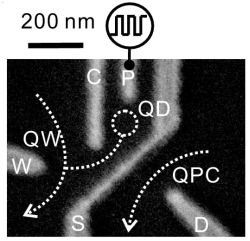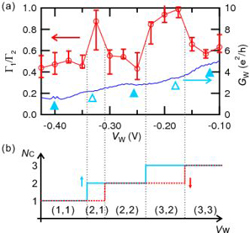Quantum Dot Spin Detector
Katsumoto Group
Electron spin is a promised candidate of a freedom to be used in next-generation devices such as quantum-bits or "spintronics" devices. A key technique to realize such devices is highly sensitive detection of electron spin polarization. However compared with charge (monopole) imbalance, which can be easily detected through the flinging electric field, detection of spin polarization through the flinging magnetic field is very difficult due to the dipole nature of spin. Hence, usually spin-polarization in solids is detected through electric transport entangled with spin polarization, which inevitably affects the spin sources. Such strong disturbance is usually fatal for fragile spin sources such as spin-orbit polarization creators in non-magnetic semiconductors. We have developed a highly sensitive method of spin-polarization detection through excited state spectroscopy with least disturbance to target devices.

Fig.1. Scanning electron micrograph of the device setup showing QD (quantum dot), QW (quantum wire), QPC (quantum point contact). P is the plunger gate, to which rectangular wave voltage is applied.

Fig. 2. (a) Measured spin polarization Γ1/Γ2(red line) and the wire conductance (blue curve) as a function of wire gate voltage. Filled triangles indicate conductance plateau with even conductance quanta (n: even) while open ones those with odd. (b) Number of conductance channels for up (cyan) and down (red) spins.
Figure 1 is displaying the device setup on a scanning electron micrograph. A quantum dot (QD) with a plunger gate is coupled to a side of a quantum wire and the flinging electric field from this set is detected by a quantum point contact (QPC) put just aside of the dot. In measurements, the electro-chemical potential of the dot is periodically swung up and down by the plunger gate voltage (Vp). This oscillation of the gate causes that of electric field which is synchronously detected by the QPC. When the base level of Vp is shifted and a discrete energy level comes into the oscillation window, single electrons begin shuttling between the wire and the dot through quantum tunneling. The shuttle motion screens the oscillation of the fringe field resulting in the diminishment of the signal, through which the tunneling probability as well as the level position can be detected.
Now we prepare an electronic state which can accommodate only an electron with a spin of certain direction, then the tunneling probability is determined by the product of orbital wavefunction overlapping and spin-direction projection due to the Pauli principle. Such preparation can be performed by various methods, e.g., by using two sequential pulses on Vp with different depths yields signal, which has monotonic correspondence with spin polarization.
We have applied the above method to detect spin polarization in quantum wire placed in strong magnetic field parallel to the two-dimensional electron gas, which forms the wire. The parallel field causes the Zeemann splitting both inside the wire and the dot. Combination of the former split and the control of the wire gate voltage can switch on and off the spin polarization in the wire. On the other hand, the latter split automatically fixes the spin state in QD, hence simple rectangular wave oscillation of Vp can produce the spin-polarization signal. Figure 2 shows the wire conductance and thus measured spin polarization as a function of the wire gate voltage. As a consequence of transverse mode formation, the wire conductance is quantized to n(e2/h), where n is an integer, e the electron charge, h the Planck constant. The spin polarization should appear when n is an odd integer and disappear for evens. Such behavior indeed appears in Fig.2 confirming that the proposed detection is really working.
